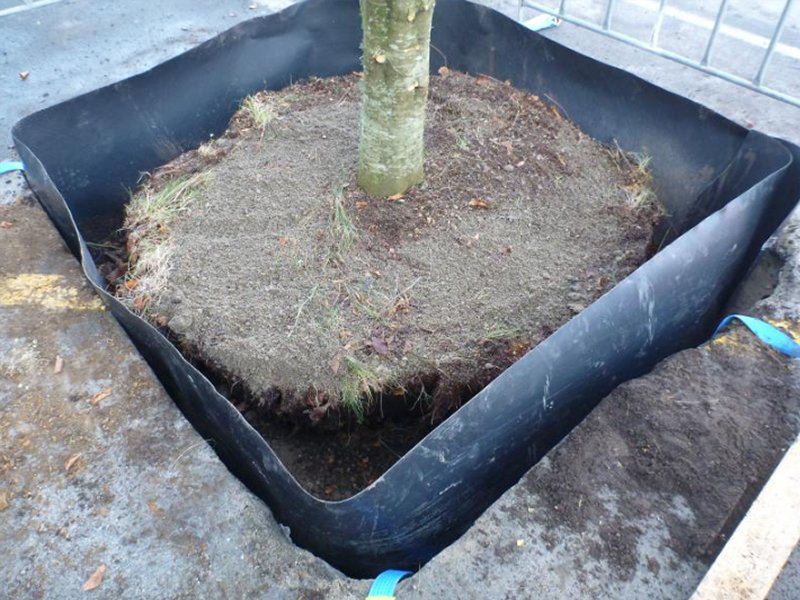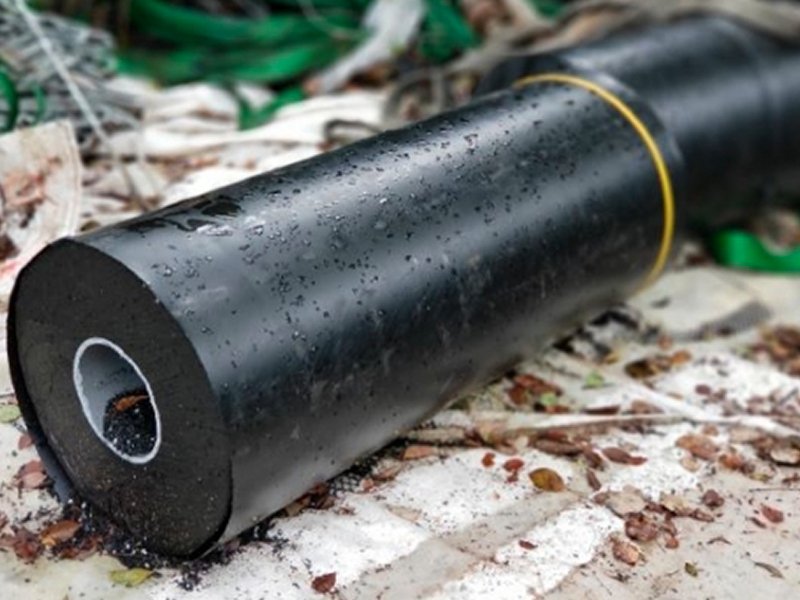HDPE membrane, or HDPE geomembrane, is composed of high-density polyethylene material. It serves as a waterproof barrier, safeguarding structures from water and vapor, as well as protecting concrete against corrosive substances and ground salts. This versatile membrane is extensively utilized in geotechnical and environmental engineering projects, ensuring containment and shielding against contamination.
As the leading geosynthetics manufacturer and supplier, GEOSINCERE offers high quality HDPE membrane in custom thickness and size in bulk order at best factory price.
1. What is HDPE Membrane
HDPE membrane, also known as HDPE geomembrane, is a waterproof barrier material made from high-density polyethylene resin. Engineered with custom formulations, it possesses key properties such as strength, flexibility, and chemical resistance. Manufactured in long rolls, HDPE membranes are installed on-site as a barrier layer to contain liquids or prevent the migration of contamination.
One of the notable advantages of HDPE membrane is its exceptional resistance to environmental stress cracking, making it highly durable. It exhibits resistance to low temperatures, anti-aging properties, and corrosion resistance. With a wide operating temperature range of -60°C to +60°C and a service life of over 50 years, HDPE membrane is extensively used in various anti-seepage projects. These projects include domestic waste landfills, solid waste landfills, sewage treatment plants, artificial lakes, and tailings treatment facilities.
HDPE membranes create a continuous bond with poured concrete, remaining unaffected by ground settlement. This characteristic allows them to act as impermeable barriers, effectively preventing the passage of water, moisture, and gas. HDPE membranes also offer good puncture resistance during the placement of reinforcement bars, ensuring their integrity and performance. They are inert and highly resistant to chemicals, acids, bases, alkalis, and salts, providing excellent corrosion resistance in a wide range of environments.
2. What Are Advantages of HDPE Membrane?
HDPE membrane has many dvantages such as strength, flexibility, chemical resistance, waterproofing capabilities, environmental stress cracking resistance, long service life, ease of installation, versatility, and cost-effectiveness. These qualities make it a reliable and preferred choice for a wide range of geotechnical and environmental applications.
2.1 Strength and Flexibility
HDPE membrane is engineered with custom formulations to provide exceptional strength and flexibility. It can withstand high loads and stresses without compromising its integrity. This allows it to adapt to different site conditions and accommodate ground movements, settlement, and other environmental factors.
2.2 Chemical Resistance
HDPE membrane exhibits excellent resistance to a wide range of chemicals, acids, bases, alkalis, and salts. This makes it suitable for applications where exposure to corrosive substances is expected, ensuring long-term durability and performance.
2.3 Waterproof Barrier
HDPE membrane acts as an effective waterproof barrier, preventing the passage of water, moisture, and gas. It ensures the containment of liquids and protects against seepage or leakage, providing a reliable solution for projects requiring water containment or isolation.
2.4 Environmental Stress Cracking Resistance
HDPE membrane is highly resistant to environmental stress cracking, which can occur due to prolonged exposure to environmental factors such as UV radiation, temperature fluctuations, and chemical exposure. This resistance ensures the long-term performance and integrity of the membrane, even in challenging conditions.
2.5 Long Service Life
HDPE membrane offers a long service life, typically exceeding 50 years. Its durability and resistance to degradation ensure that it can withstand the test of time, reducing the need for frequent replacements and maintenance.
2.6 Ease of Installation
HDPE membrane is manufactured in long rolls, allowing for efficient installation on-site. It can be easily welded or seamed together to create a continuous and seamless barrier, ensuring proper containment and minimizing the risk of leaks or weak points.
2.7 Versatility
HDPE membrane finds applications in diverse fields, including waste containment, water storage, mining, agriculture, and civil engineering. Its versatility stems from its ability to provide reliable containment and protection in different environments and against various substances.
2.6 Cost-Effective
Considering its long service life, durability, and minimal maintenance requirements, HDPE membrane offers a cost-effective solution over its lifespan. It helps reduce the overall project costs and provides long-term value.


3. What Is HDPE Membrane Used For?
3.1 Landscaping Application
HDPE water barrier can indeed be utilized as a root guard for trees, bamboo, and weeds, effectively preventing the spread of roots throughout the landscape. In such applications, customized HDPE membrane options are available, specifically designed for foundation waterproofing and root containment. The following are examples of the material dimensions and thicknesses commonly used in these cases:
3″ x 3″ Pieces: Available in 30 Mil, 40 Mil, 60 Mil, and 80 Mil thicknesses.
Rolls:
- 10″ x 100′ Roll: 80 Mil Thickness
- 18″ x 100′ Rolls: Available in 30 Mil, 40 Mil, 60 Mil, and 80 Mil thicknesses.
- 24″ x 100′ Rolls: Available in 30 Mil, 40 Mil, 60 Mil, and 80 Mil thicknesses.
- 30″ x 100′ Rolls: Available in 30 Mil, 40 Mil, 60 Mil, and 80 Mil thicknesses.
- 36″ x 100′ Rolls: Available in 30 Mil, 40 Mil, 60 Mil, and 80 Mil thicknesses.
- 48″ x 100′ Rolls: Available in 30 Mil, 40 Mil, 60 Mil, and 80 Mil thicknesses.
- 48″ x 80′ Roll: 80 Mil Thickness
- 60″ x 80′ Roll: 60 Mil Thickness
These dimensions and thicknesses provide a range of options to suit different project requirements and ensure effective root containment. The choice of size and thickness depends on factors such as the type of plant, the desired level of root restriction, and the specific landscape conditions.
By using HDPE membrane as a root guard, the spread of plant roots can be controlled, preventing potential damage to infrastructure, hardscapes, or adjacent planting areas. The impermeable nature of HDPE membrane effectively acts as a barrier, confining the roots and maintaining the desired landscape design and functionality.
3.2 Mining Application
HDPE membrane plays a crucial role in ensuring environmental protection and regulatory compliance in mining operations by providing reliable containment solutions for various waste materials, process fluids, and water resources. Its impermeable properties, durability, and chemical resistance make it well-suited for the challenging conditions encountered in the mining industry.
3.2.1 Tailings Storage Facilities (TSF) Liners
HDPE membrane is used to line tailings storage facilities, which are used to store the waste materials generated from the mining process, known as tailings. The impermeable properties of HDPE membrane help to prevent the seepage of contaminants from the tailings into the surrounding soil and groundwater, minimizing environmental impact and protecting nearby ecosystems.
3.2.2 Heap Leach Pads
In heap leach mining operations, HDPE membrane is employed to line the leach pads where crushed ore is stacked and leaching solutions are applied to extract metals such as gold, copper, or uranium. The HDPE liner prevents the leachate solution from infiltrating into the underlying soil and groundwater, ensuring containment and environmental protection.
3.3 Evaporation Ponds
HDPE membrane is used to line evaporation ponds, which are used to store and evaporate water from mining operations, such as process water or wastewater. The impermeable barrier provided by the HDPE liner helps to minimize water loss through seepage and ensures proper containment of potentially contaminated water.
Water Storage and Treatment: HDPE membrane is utilized in water storage reservoirs, ponds, and treatment facilities associated with mining operations. The liner helps to prevent seepage and contamination of water sources, ensuring that water used for mining processes or discharged from operations meets environmental regulations and quality standards.
3.4 Secondary Containment
HDPE membrane is employed in secondary containment systems for storing hazardous materials, chemicals, and fuel storage tanks at mining sites. The liner provides an impermeable barrier that prevents leaks or spills from contaminating the surrounding soil and groundwater, minimizing environmental impact and regulatory compliance risks.


4. How To Install HDPE Membrane?
Installing HDPE membrane requires specialized knowledge and equipment to ensure proper performance. Here are some key considerations for installing HDPE membrane:
4.1 Certified Welding Technicians
HDPE membrane installation should be carried out by certified welding technicians who are trained in the proper welding techniques. This ensures the integrity of the seams and overall performance of the membrane.
4.2 Temperature and Weather Sensitivity
HDPE membrane installations are sensitive to temperature and weather conditions. Ideally, installations should be done in suitable weather conditions to ensure optimal welding and bonding of the membrane.
4.3 Subgrade Preparation
For 40 mil HDPE liner, extra effort should be put into preparing the subgrade to ensure it is in excellent condition. This may involve leveling, compaction, and addressing any sharp objects or irregularities that could potentially damage the membrane.
4.4 Application Considerations
The thickness of the HDPE liner should be chosen based on the specific requirements of the project. A 60 mil HDPE liner is commonly used for most applications, while an 80 mil HDPE liner is recommended for more aggressive subgrades that may pose increased challenges.
4.5 Layered Systems
In some cases, HDPE liner may be part of a multi-layered system. This can include layers such as a subgrade, geotextile layer, drainage net layer, and additional HDPE layers. Each layer serves a specific purpose in enhancing the overall performance and functionality of the system.
4.6 Quality Assurance
During installation, it is important to conduct quality assurance checks to ensure proper welding, seam integrity, and adherence to installation guidelines. This may involve visual inspections, non-destructive testing, or other relevant methods to verify the quality of the installation.
It is crucial to consult and follow the manufacturer’s guidelines and recommendations specific to the HDPE membrane being used. Proper installation is essential for maximizing the performance and longevity of the HDPE membrane system.
5. About GEOSINCERE
GEOSINCERE is the leading geomembrane and geosynthetics manufacturer and exporter located in Shandong Province, China. Founded in 2010, we are offering an extensive selection of geosynthetic products including geotextile fabrics, geomembranes, geocells, geogrids, geosynthetic clay liners (GCLs), drainage boards, etc. Product innovation, quality assurance and customer satisfaction are our long term commitment to all our customers. Looking for worldwide dealers.






Leave A Comment